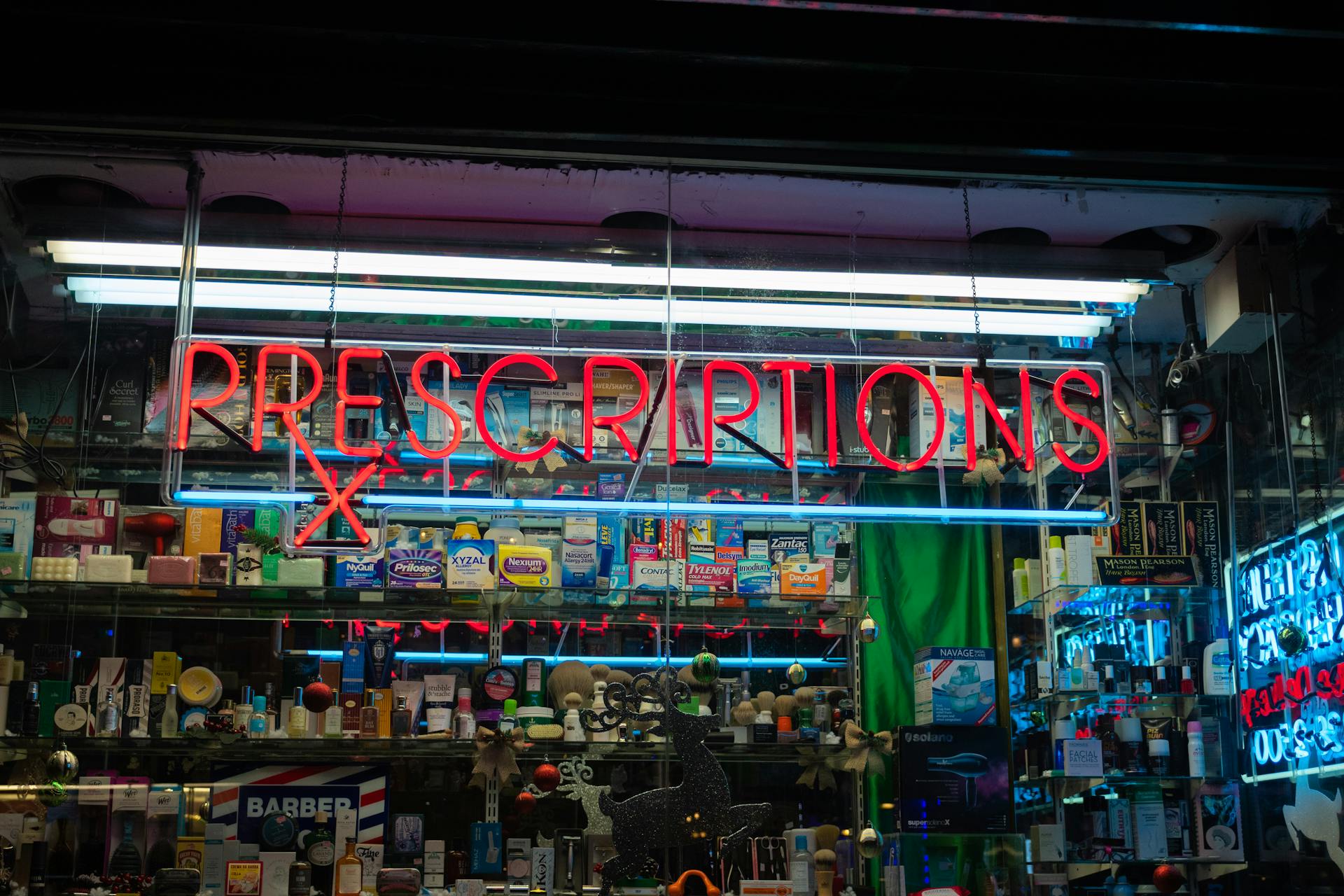
Supplemental insurance can be a game-changer for managing prescription costs. Many people rely on these policies to cover expenses not fully covered by their primary insurance.
Supplemental insurance can be purchased separately or bundled with other policies, such as Medicare Advantage plans. This can provide extra protection for those with ongoing medical expenses.
Some supplemental insurance policies specifically target prescription coverage, offering discounts or reimbursement for certain medications. For example, some policies may offer 10% discounts on generic prescriptions.
These policies can be tailored to meet individual needs, but it's essential to review the terms and conditions before purchasing.
A fresh viewpoint: Types of Supplemental Insurance
Supplemental Insurance Options
You can also get prescription coverage through supplemental insurance options, which can be a good fit if you're already eligible for Medicare. Medicare Part D coverage has some changes coming in 2024 and 2025, so it's essential to understand your options.
There are a few ways to get supplemental prescription coverage, including purchasing a stand-alone Medicare Part D Prescription Drug Plan, which can be used in tandem with Original Medicare. You can also opt for a Medicare Advantage plan that includes Part D prescription drug coverage, known as an MA-PD.
Explore further: Adult Supplemental Term Life Insurance

If you're eligible for Medicaid, you can get supplemental coverage through them, which will be via Part D. Your employer or a spouse's employer may also offer supplemental coverage, including retiree coverage that's comparable to Part D coverage.
Here are some options to consider:
- A stand-alone Medicare Part D Prescription Drug Plan
- A Medicare Advantage plan with Part D coverage (MA-PD)
- Supplemental coverage from Medicaid or your employer/spouse's employer
Medicare
Medicare is a crucial part of the healthcare system for many Americans, especially those over 65. Medicare Part A and B cover a range of medical expenses, but not prescription drugs.
Original Medicare doesn't cover prescription drugs, which is why Medicare Part D was established in 2003. This program provides prescription coverage for Medicare enrollees and requires buying a private prescription plan.
There are three main options for obtaining prescription coverage once you're eligible for Medicare: a stand-alone Medicare Part D Prescription Drug Plan, a Medicare Advantage plan that includes Part D prescription drug coverage, or supplemental coverage from Medicaid or your employer.
The majority of Medicare Advantage plans are known as MA-PDs, which include Part D prescription drug coverage. You can also get supplemental coverage from Medicaid or your employer, which will be via Part D.
Broaden your view: Does Bcbs Federal Cover Weight Loss Drugs

As of 2021, 48 million people with Medicare were in Medicare Part D drug benefit, which represents 77% of all Medicare beneficiaries. This is a significant reduction in the cost of prescription drugs for many people.
Here are the three options for obtaining prescription coverage:
- A stand-alone Medicare Part D Prescription Drug Plan
- A Medicare Advantage plan that includes Part D prescription drug coverage (MA-PD)
- Supplemental coverage from Medicaid or your employer
Medicaid covers prescription drugs in every state, with recipients paying either a small copay or nothing. However, people who are dual-eligible for Medicaid and Medicare receive prescription drug coverage through Medicare Part D.
Readers also liked: Managed Care Organization Medicaid
Medigap
Medigap is a type of supplemental insurance that helps fill the gaps in Original Medicare coverage. It's available to anyone with Medicare Part A and Part B.
Medigap plans are standardized, meaning they offer the same benefits regardless of the insurance company selling them. There are 10 standardized plans, labeled A through N.
Plan F is the most comprehensive Medigap plan, covering 100% of Medicare-approved expenses for hospital stays, doctor visits, and other services. However, it's no longer available to new Medicare enrollees as of 2020.
Plan G is another popular option, offering 80% coverage for Medicare-approved expenses. It's a good choice for those who want more comprehensive coverage without breaking the bank.
Explore further: Comprehensive Health Insurance
Prescription Coverage

Prescription coverage can be a vital component of supplemental insurance. Some plans, like Health ProtectorGuard, offer a fixed benefit for a set number of prescription fills per person, per calendar year.
This benefit applies to any FDA-approved medication, generic or brand, and can be submitted for reimbursement. Health ProtectorGuard plans also come with an Optum Perks discount card that can provide savings of up to 30-80% at participating pharmacies.
You can use your Optum Perks card to get estimated drug prices and check if a specific pharmacy participates. Note that the amount of the discount can vary from one pharmacy to another.
If you have a major medical plan, you may need to stay with certain networks and providers to get the most coverage out of that plan. This is not the case with Health ProtectorGuard plans, which allow you to visit any pharmacy in the U.S. and submit your claim for reimbursement.
Some supplemental insurance plans offer stand-alone prescription coverage, which works similarly to medical insurance. You pay an annual premium and then have a copay or coinsurance cost at the pharmacy.
A fresh viewpoint: Does Pet Insurance Cover Prescription Food
Pharmacy Coverage

You can get your prescription medications filled at any pharmacy in the U.S. with a Health ProtectorGuard plan. The plan does not require you to stay within a network, so you can visit any pharmacy and still get the benefits.
The Optum Perks discount card included with all Health ProtectorGuard plans offers discounts for FDA-approved prescription medication. It can provide savings of up to 30-80% at most U.S. pharmacies.
You can use the Optum Perks card to get estimated drug prices and check if a specific pharmacy participates by calling 1-866-407-8901.
Explore further: Italian Health Insurance Card
Medicare Part D Coverage
Medicare Part D is a federal program that provides optional prescription drug coverage to Medicare beneficiaries in the United States. It is part of the Medicare Prescription Drug, Improvement, and Modernization Act of 2003 and became effective on January 1, 2006.
As of 2021, 48 million people with Medicare were in Medicare Part D drug benefit, which represents 77% of all Medicare beneficiaries.
If this caught your attention, see: Bcbs Medication Coverage

Medicare Part D coverage is offered by private insurance companies and provides beneficiaries with access to a formulary of prescription drugs at a reduced cost. This coverage is an important resource for beneficiaries who take regular medications.
Medicare Part D requires buying a private prescription plan, and there are a few avenues for obtaining prescription coverage once you're eligible for Medicare. These options include:
- A stand-alone Medicare Part D Prescription Drug Plan
- A Medicare Advantage plan that includes Part D prescription drug coverage (MA-PDs)
- Supplemental coverage from Medicaid or your employer or a spouse's employer
As of 2024, Medicare Part D coverage no longer has unlimited out-of-pocket exposure, and out-of-pocket exposure under Part D will be further reduced starting in 2025.
A different take: How to Get Insurance to Cover Vitamin D Test
Medical Plan Information
To find out what's covered under your medical plan, you can check the benefit plan documents provided by your health plan. This is the most accurate source for checking if a medication is covered.
Prescription drug lists are available by category and can be found on your health plan's website or in their documentation. Look for the Prescription Drug List (PDL) by category.
Discover more: Does Bcbs Cover Drug Rehab

You can also look up a medication by name to see if it's covered under your plan. This feature is available on many health plan websites.
Drug prices are subject to change and are not determined by the health insurance company. You and your representative can request an exception to gain access to an excluded medication.
Here's a summary of what you can do to access your medical plan's pharmacy and drug coverage information:
- Check the benefit plan documents for the most accurate information
- Look up a medication by name
- Request an exception to gain access to an excluded medication
Insurance Plans
Supplemental insurance plans can be a game-changer for managing prescription costs.
Some plans, like Medigap, cover 100% of prescription costs after the Medicare Part D deductible is met.
Medigap plans, however, are only available to Medicare beneficiaries.
Supplemental insurance plans like Medicare Supplement Insurance can be purchased separately or through a Medicare Advantage plan.
These plans can help fill gaps in coverage left by Medicare Part A and Part B.
Here's an interesting read: What Does Aetna Supplemental Insurance Cover
Cost and Savings
Wellcare offers low-cost PDP plans with affordable coverage on thousands of prescription drugs.
These plans are designed to support your health and help you live a healthier life.
Low monthly payments make it easier to manage your expenses.
All of Wellcare's plans offer $0 copays on Tier 1 generics at preferred pharmacies.
See what others are reading: Dental Insurance Arkansas Low Income
Sources
- https://www.uhone.com/resources/prescription-drug-coverage
- https://www.bcbs.com/explore-affordable-health-plans/medicare/prescription-drug-coverage
- https://www.verywellhealth.com/prescription-drug-insurance-4013242
- https://www.senior65.com/medicare/article/medigap-prescription-drug-coverage-at-the-pharmacy
- https://www.wellcare.com/en/explore-plans/prescription-drug-plans
Featured Images: pexels.com


